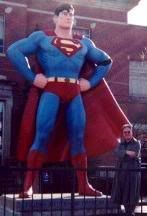| Pop Culture Gadabout | ||
|
Friday, December 30, 2005 ( 12/30/2005 10:07:00 AM ) Bill S. "ONLY NOTHING IS IMPOSSIBLE, FLORA!" – So is All-Star Superman the best superhero comic of the year? I'm not the blogger to be making any definitive statements on that score: since March, my new superhero book purchases have been minimal. On the one hand, this means I've missed such non-events as "House of M" and "Infinite Crisis," though I do plan to catch up on things like the Seven Soldiers of Victory books through the inevitable trades. So let's just note that the premiere ish of Morrison & Quitely's take on the Man of Steel is the first fresh company comic booklet I've bought in months – and that I wish more genre books had its intelligence and goofy inventiveness. The book begins – and smartly so – with a four-panel origin recap that's less about actually retelling a story that everyone in the audience knows and more about establishing mood and ground rules. I'm not gonna baby step you through this, scripter Morrison is saying, and true to his intentions he doesn't. What makes Morrison the ideal scripter for entertainments like this is his faith in his audience and realization that comics are an art form that the reader can pick apart at its leisure, read and reread backwards and forwards – and will if the talent involved gives 'em enough reason to dig into the work. It's an elementary concept, but one that few mainstream comics scripters (who still write from the Read-It-Once-on-the-John dictate) seem to follow. But Morrison appears temperamentally unable to write a simple-minded superhero book – even for as paradigmatic a character as this – in part, I suspect, because to do anything less with the material would bore the guy to tears. So instead we get characters and information efficiently imbedded into the material, there in plain sight for the reader to see – but not garishly highlighted with extensively expository dialog or narration. Take a simple sequence that occurs in the final pages of issue #1, where Clark Kent and Lois Lane are on a crosswalk and our hero bumps into and knocks down a pedestrian. At first we think it's just another moment where the disguised Superman is establishing his alter-ego's klutziness, but off to the side of the page-wide panel, we see that Clark has actually saved the unknowing pedestrian from a falling piece of floating signage. It's a moment you almost miss (and, indeed, Lois appears to), and the first time I read through the book, I actually did. In an earlier comics era, we would've probably gotten two panels of Superman seeing the impending peril and furiously thinking, "How can I save this fella without giving away my secret identity to that perpetually curious Lois? But, instead, it's just presented as just another day-to-day moment in the life of the Man of Steel. It helps tremendously that Morrison has an artist as skillful as Frank Quitely to pull this kind of moment off, of course, but what also separates Morrison from many of his contemporaries (apart from his willingness to sneak a mildly risqué joke into one of his Daily Planet scenes) is his ability to show characters in an s-f setting who believably reflect the different-ness of their futuristic setting without losing track of their core humanity. Writer Ray Bradbury gets name-checked in the first issue, but the one I keep coming back to Phillip K. Dick, a master when it came to reflecting the perceptual shifts that progress or sudden change can bring. From his more out-there reality bending comics (c.f., The Filth), it's obvious Morrison has clearly learned many of the more obvious story tricks from Dick, but he's also absorbed the subtler ones, too. A lot of comics writers could've come up with the same amount of science-fictional gobble-de-gook (how does Superman extend his "bioelectrical field" again?) as Morrison, but few could've parked it in as believable a story world. A quick example from issue #1 and then I'll shut up. We're in The Daily Planet while Superman is soaring to the sun, racing to save a ship of solar explorers who are victims of a commendably ridiculous scheme of Really Evil Lex Luthor's. We see reporter Lois Lane working on her story for the paper and learn through a jealous reporter that, though Superman is still in the midst of his rescue mission, Lois has already written the banner headline for it indicating that he was successful. "I always write the Superman headlines before they happen, Steve," she says, and we believe this assertion because we know a.) that newspaper deadlines often require parts of the piece to be written before the final story is concluded and b.) that Lois simply can't conceive of Superman failing in his task. He's so long been a part of life in her world that any other headline is unthinkable. That she's essentially right, of course, has long been the challenge facing every writer who's ever had to deal with Superman (we all know our hero will escape any "elaborate super-death trap" that Bad-Ass Luthor sets out for him). But on the basis of his first issue, it's clear that Morrison is more than up to the challenge . . . # | |
|
|

